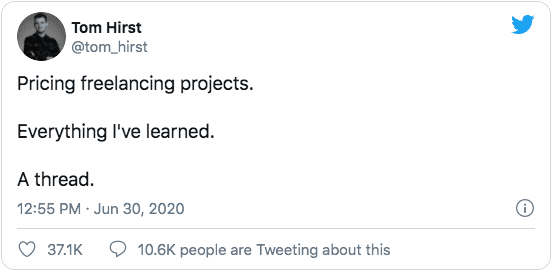Pricing Freelance Projects
I wrote a Twitter thread about my experience, learning and knowledge on pricing projects as a freelancer.
Over the next 36 hours it’d gained tens of thousands of likes.
Here’s “Pricing freelancing projects. Everything I’ve learned. A thread.” eternalised in article form:
Pricing Strategies
Having one pricing strategy that you can apply to every real-world engagement is often a fallacy.
Learn these pricing methodologies:
- Hourly billing
- Daily billing
- Retainers
- Fixed-pricing
- Value-based pricing
Understand their pros and cons.
Understand your circumstances.
Understand the project.
Choose appropriately.
You don’t have to use the same pricing methodology for every engagement.
- Client 1: Day rate
- Client 2: Fixed priced project
- Client 3: Ongoing retainer
Use the strategy that fits the work best.
Hourly Billing
Charging by the hour doesn’t work in favour of freelancers.
If you need to use it to get started, stop using it as soon as you can.
Hourly billing is by far the worst pricing methodology to use for profit.
Hourly billing is by far the worst pricing methodology to use for efficiency.
Do you want to avoid:
- Estimating every small task?
- Filling out timesheets?
- Sending tons of invoices?
- Having to justify every time you go “over”?
Avoid hourly billing.
Daily Billing
There are two ways to bill daily:
1 day = 8 hours or 1 day = 1 day.
Always use the latter.
The former robs you of your autonomy.
If you want to raise your rates in future, when billing by the day, max out at selling 4 days per week to clients.
Give yourself time to grow your own business.
If you bill your client daily, you’re giving them a day’s work.
Nothing else.
It’s a rolling engagement for a reason.
Day rate can’t come with a guarantee of completion.
“Day rate” where you guarantee a set amount of logged hours is worse than billing hourly.
It’s billing hourly for less money.
Fixed-Pricing
Rules for fixed-price projects:
- Get a deposit
- Get a fixed scope
- To reduce the price you must reduce the scope
- Don’t use estimated days x day rate = price
- Add a minimum 20% contingency
- Price high enough to make a profit after you’ve paid yourself
Remember that when you give a fixed-price for a scope of work, you are guaranteeing completion.
Going back to the table for more money at this stage leaves a bad taste.
Fixed-price projects are highly beneficial to efficient freelancers.
If quality is retained.
Fixed-price terms are nearly always best.
Value-Based Pricing
Value-based pricing requires the most effort when making offers.
But you should still research your client when using other strategies.
How valuable will you be to them?
Value-based pricing TLDR version:
Your client’s average lead value = £500
You estimate that your work will get them 100 leads in year 1.
That’s £50,000 of value.
You give a price for your work based on a % of that figure.
If you can show the value, you can justify the price.
Retainers
Retainer agreements are a useful safety strategy.
Give preference to retainer engagements that sell your availability to deliver knowledge, not your labour.
Proposals
Don’t get tricked into sharing tons of project specific information in a proposal.
If you can’t write a proposal without research then you need a pre-project.
Discovery work has value and should come at a price.
Proposals > estimates.
Estimates
Estimates are never accurate.
Deposits
Get. A. Deposit.
Your Value
You can’t charge a premium if your individual value isn’t obvious.
Things that increase perceived value and thus project price:
- The scarcity of your time (availability)
- What you’ve done before (credibility)
- The project price itself
Reducing your price means reducing your perceived value.
If you don’t also reduce scope.
Positioning
If you’re the most expensive option, and a prospect who cares can’t understand why, your positioning is off.
Price tells it’s own story, but it needs back up from credibility.
Availability
If you’re instantly available, expect to be asked to lower your price.
Risk
If it’s most risky for you to work with the client the price should be higher.
If it’s most risky for the client to work with you the price will be lower.
Price mirrors risk.
Negotiation
Never use your bottom line as your price.
Negotiate on terms, not price.
Safety Money
When a hard deadline is introduced to a fixed-price project, add 20%.
If you think there’s a chance you might kick yourself for not charging enough, it’ll probably happen during the project. Add 20%.
Things To Note
Some people will pick the cheapest price because it’s the cheapest.
Some people will pick the most expensive price because it’s the most expensive.
The way that pricing methodologies are received differs from country to country.
Be aware of this when making offers.
Sometimes pricing a freelancing project can be as simple as:
Freelancer: “I’m happy to do the work for this price”.
Client: “I’m happy to pay this price for the work completing”.
Summary
Pricing freelancing projects is tough.
There’s no one-size-fits-all solution.
Understand each method.
Have your preferences.
Be aware of your position.
Gauge what your clients are most likely to accept.
Apply the most appropriate strategy to get the job at a price you’re happy with.
Pricing Freelance Projects The Book
“Pricing Freelance Projects” the book, is available now!
All the details of pricing myself to a six-figure yearly freelance career are inside.
It’s a value-packed ~30,000 words across 135 pages.
If you liked the thread, you’ll love the book!
Get “Pricing Freelance Projects” Now

